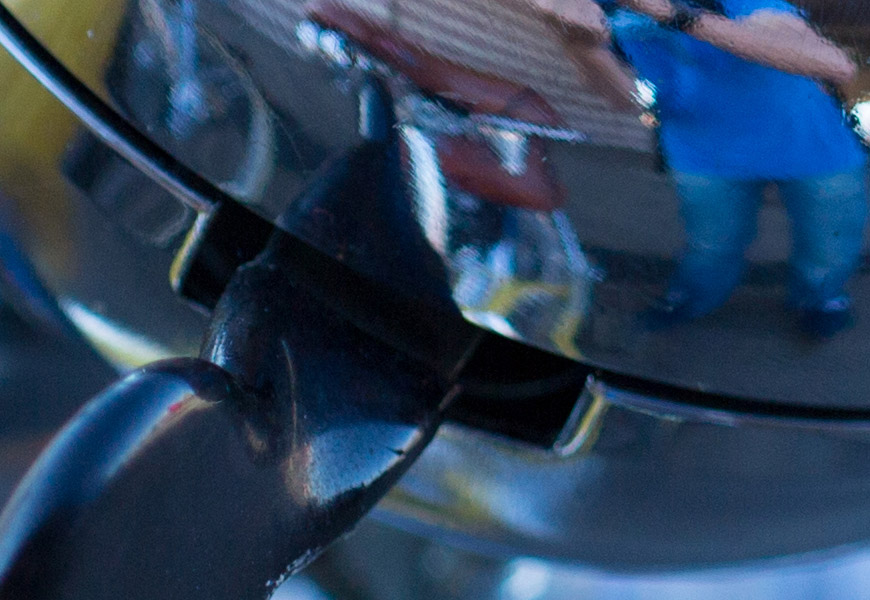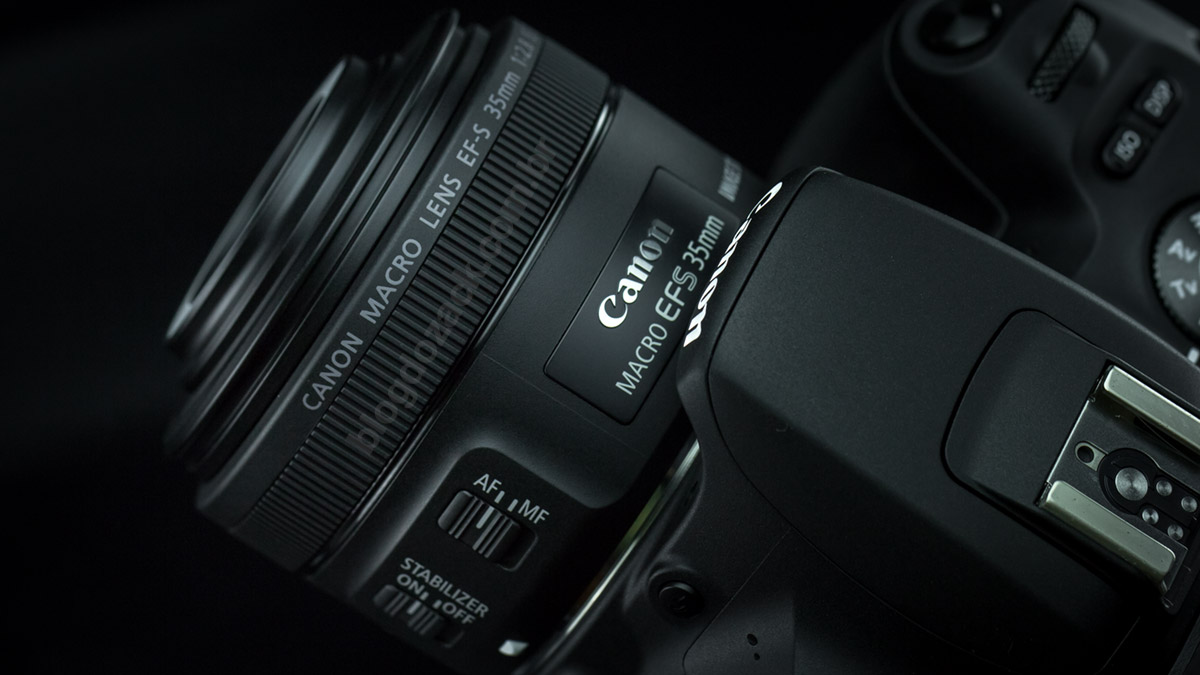Estimated reading time: 11 minutes.
April/2018 – The EF-S 35mm f/2.8 Macro IS STM introduced in 2017 is nothing less than the tenth “35mm” lens we see on blog do zack. A popular focal length used to cover the “end” of the wide-angle on a full-frame 135-format camera, equivalent to a 56mm lens when used on an APS-C sensor, this lens is also the widest Macro prime ever from Canon; a curious addition to the high-performance EF prime lineup. Typically Canon, the new EF-S 35mm tries a lot of different things on a single lens, and brings a great feature-set never before seen at this price point: it’s perfectly capable of focusing at infinity, thus performing like a regular 35mm lens for portraits and landscapes (56mm equiv.); it sports an integrated image stabilizer, using three “Hybrid IS” sensors to calculate the hand’s angular movements; and even features a gimmicky LED illumination at the front, making it easier to shoot macro shots. Putting its legacy at risk, together with a overly crowded 35mm market, is the US$349 EF-S 35mm the missing lens from Canon? Let’s find out!

At 69 x 56mm of 190g of mostly plastics, the first thing we notice on the new EF-S 35mm f/2.8 IS STM it it’s size; the smallest 1:1 macro lens ever from Canon, and also the lightest; perfect for the entry-level APS-C cameras. Slightly larger than the 50mm f/1.8 STM, its secret is in the wider focal length that’s invariably short, forcing you to get really close to your subject at the 1:1 macro ratio; thus the purchasing decision comes immediately from this. Not every subject allows for such a close working distance when shooting macro, for example insects that fly away, and this 35mm asks for a mere 13cm at the minimum focusing distance (MFD) – including the camera – less than ideal for very small objects. So for those type of motifs I’d recommend a longer macro lens like both 100mm f/2.8 USM/L IS USM, also giving different depths of field and compositions; not every macro lenses does the exact same things. But on the other hand what this 35mm f/2.8 has in short it has in practicality, and together with having Canon’s newly designed ergonomics with a smooth outer barrel and all-internal focusing group, it’s very solid for an EF-S lens.

In your hands the ergonomics are interesting given the thick outer barrel that’s a pleasure to use, paired with a great balance towards the camera; this lens doesn’t “disappear” in front of the camera like some pancake lenses. The left hand fingers have plenty of room to grab on to, with no bumps along its sides nor sharper edges around the all-plastic construction; it’s all smooth to the touch. Even the side switches are recessed into the lens body, featuring both the IS and AF on/off adjustments, made not to be accidentally bumped when in use or in storage. But at the front the manual focusing ring unfortunately uses Canon’s STM electronic focus control, mechanically disconnect from the internal focusing group, thus fairly imprecise; a deal breaker for professional macro photographers. On the other hand it all makes for a much simpler lens to use to the amateur market, and there’s not even a distance window guiding the focusing point; the “macro” certainly feels like an extra feature on this lens, not its real main selling point.

Inside Canon opted for its newer STM focusing system, smooth and silent; and also surprisingly quick. Despite using a stepping motor designed for smoother transitions during video recording, this 35mm f/2.8 with an all-internal focusing group can easily switch between subjects; certainly a step ahead other Canon STMs like the EF-M22/EF-S24/EF40; all using an expansive focusing barrel that takes longer to achieve focus. Here demonstrated with the EOS Rebel SL2 using a phase-detection module through the viewfinder, or a Dual Pixel image sensor during Live View, the EF-S 35mm focusing speeds are excellent in shorter distance changes; and under a second when it moves from infinity to MFD. Also its precision is fairly good with most Canon EOSs, and absolutely no shot during this review came out of focus; excellent for a low-cost prime!

Also inside Canon used it’s latest Hybrid IS module in the EF-S 35mm f/2.8, a major highlight. Firstly introduced in the 2009 top-of-the-line EF 100mm f/2.8 L IS Macro USM, and then on the EF 24-70mm f/4L IS USM zoom, the idea is to use three separate gyroscopes to calculate not only the linear hands movement but its rolling axis; typical of the macro photography. Although the lens isn’t capable of effectively rolling the focusing groups (that would take the image plane out of focus), this lens is rated up-to 4-stops of compensation when the IS is active, perfect for taking sharp images even without a tripod. And I could easily get sharp details at up-to 1/10s shutter speeds with the camera in hands, and it’s practicality in uncanny; this could easily be that “stabilized 50mm” (at least on the APS-C format) that Canon never launched. And also during video recording the IS is welcomed, allowing for stabilized video capture with professional results.

“Rocks” with the EOS M at f/2.8 1/10 ISO400.

Crop 100%, the stabilizer held the composition steady for up-to 1/10 of a second.

Finally at the front the EF-S 35mm f/2.8 IS STM features a novelty LED light system, offering up-to a full stop of light forming a semi-ring around your subject; making it easier to shoot at the 1:1 ratio. It’s manually activated via a left hand button for 1 or 1/2-stops, using both LEDs, and unfortunately it can’t be automatically set; it’s not like a proper flash system. The idea is to shine an extra stop of light when focusing at the 13cm minimum focusing distance, giving interesting results. While it’s far from a dedicated ring unit, the 35mm f/2.8 built-in LEDs are more than enough to avoid shadows on smaller subjects. Because on them the frontal cover is a bit more complicated than usual with a pinch mechanism, and the ø49mm filter thread demands a special included-in-the-box ES-27 adapter, made of metal (!) and doubling as a lend-hood; it’s all easy to use and impressive as a US$349 kit. At the rear the metal mount includes an extra rubber bump that prevents EF-S lenses to be mounted on full-frame cameras, despite not including a proper rubber gasket for some weather sealing protection. But overall it’s all well put together, and straight to the point: a true macro lens.

“I’m bee” at f/8 1/320 ISO800; all photos with the EOS M.
With a bold 10 elements in 6 groups optical formula (most 35mm uses far less glass pieces), one “glass-molded” aspherical (made inside a mold, cheaper than polishing every copy by hand), and a 7-blade rounded aperture (for better bokeh), what the EF-S 35mm f/2.8 IS STM delivers optically is impressive; one of the best 35mm lens we’ve ever seen on vlog do zack despite the ease of use. Also this is one of the cheapest lens we’ve seen at this focal length, but the “macro” moniker proves Canon wasn’t joking when it developed its optical formula. Even wide open the details and contrast are excellent, easily surpassing the demands of any 24MP APS-C sensor, with high impact images. Stopping down merely fixes some of its vignetting for an uniform frame. And the chromatic aberrations are well controlled, practically invisible on the axial planes. If it wasn’t for its stronger-than-usual geometric distortion that, paired with its relatively poor flaring control (when it happens), it could easily fit even the more expensive kits. Finally its colors are the icing on the cake with Canon’s saturated tones, far from reality but pretty in print or screens. So everything just works: great images, good details and a lack of aberrations; a true “macro” EF-S lens.

“Post” at f/32 0.3s ISO100; long hand-held exposure, without the need of a tripod.
Wide open at f/2.8 what the 35mm IS STM delivers is exemplary, maybe the best we’ve seen from Canon at this focal length; behind maybe only the top-of-the-line EF 35mm f/1.4L II USM. Yes, this US$349 EF-S is superior to the EF 35mm f/2 IS USM and even the vintage EF f/1.4L USM, both with contrast and resolution issues at f/2.8, also with excessive chromatic aberrations. At f/2.8 this EF-S can keep the contrast intact at any focusing distance thanks to its “macro” design that, paired with the extra resolution across most of the frame (except the far edges), exponentially enhances the perceived sharpness for high precision shots. Here shown mostly during the day with the EOS M, the performance is scary good: every detail on smaller subjects, close to the macro range; every detail on landscapes at infinity focus; every detail under low-light, thanks to the built-in stabilizer; and perfect wide-open portraits, including all the details. It’s a performance similar to Sigma’s first Art series 35mm f/1.4 DG HSM, but here on Canon’s entry-level lineup.

“Puerto Rico” at f/2.8 1/640 ISO100.

Crop 100%, impressive wide open details, “inside” the shallow depth of field.

Crop 100%, few sharp elements at the closest focusing distance, but the contrast and resolution are great.

Crop 100%, impressive quality from the low-cost lens.
Stopping down merely controls the depth of field from the reasonably large APS-C sensor, fixing the vignetting for smoother frames. The macro photography is one of the hardest to master given the shorter working distances, thinner depths of field and sharper image planes, asking for exotic photographic techniques to keep everything in focus. So it’s impressive to see this level of performance as soon as f/4, excellent for high-precision shots even from cheaper lenses; a similar performance to the also excellent STM 24mm and 40mm lenses. It’s a pleasure to use this smaller aperture paired with slower shutter speeds, assisted by the Hybrid IS module, for incredibly detailed shots all-across the frame. It’s a new paradigm to the APS-C format: those looking for raw performance don’t really need to carry a large camera anymore, nor large aperture prime lenses that are expensive to manufacture; it can all be done with an APS-C camera.

Crop 100%, scary good resolution from the low-cost APS-C format.

Crop 100%, plenty of details for high precision shots.

Crop 100%, shallow depth of field even 1-stop down.
The chromatic aberration control is also impressive given the out-of-focus quality; one of the smoothest without chromatic aberrations nor light leaks; typical of Canon’s modern macros. Nobody really notice it, but the EF lineup is the only updated for high-end macrophotography: despite the specialty MP-E 65mm 1-5X and every new TS-E Macro Ls – exclusive on the market – nor Nikon, nor Sigma, nor Fuji nor Sony offers anything similar on the macro market. Nikon’s AF-S 105mm f/2.8G IF-ED is an outdated lens: its axial aberrations can’t deliver the precision asked from contemporary digital imagers, and there’s no plans to update it soon. Those shooting with Sony’s E-mount don’t even know what macro is for. But Canon’s EF-S 35mm f/2.8 IS STM deliver top-of-the-line performance on a simple to use package, easy to recommend even to professionals.

Crop 100%, exemplary performance for the focal length.

Crop 100%, intact textures and practically no chromatic aberrations.

Crop 100%, axial aberrations only on the closest out-of-focus bits and at the minimum focusing distance.
”Leafs” at f/4 1/640 ISO100; before and after some contrast compensation.On the other hand the overall geometry is not the best on the EF-S 35mm f/2.8 IS STM, showcasing the limits of an accessible wide angle lens; asking for mandatory software compensations. It’s kind of expected: a perfect geometry needs more optical pieces to perfectly fit the wide-angle on the flat sensor surface, and here they are used to compensate for hands movements via the IS module; not the geometry of lines. So architecture and landscapes photographs can get an obvious bulge near the frame’s edges, fixed on DIGIC6 cameras or better; or in-post processing. The same can be said about the internal reflections (flaring) that are also not the best, and any in-frame light source can make the glass render unwanted blobs of light; severely limiting the overall contrast. So this EF-S 35mm might not be the “do-it-all” wonder I was expecting: carefully position your light source.
Finally the colors delivered by the EF-S 35mm f/2.8 Macro IS STM are, by the tenth time, the most saturated – happy! – vivid! – vibrant! – intense! – of any vlog do zack review. It’s simply staggering to run a review website where I test every brand: Nikon, Sigma, Tamron, Toking, Fuji and Sony doesn’t come close to Canon’s color science, and we always get the most colorful photo albums from this manufacturer. Yellow tones are pure without any influence of the blue and green hues on landscapes; with subtle red tones to enhance saturation; but not orange as used by Fuji; nor neon looking like Sony; nor opaque like Nikon. The reds are so intense they sometimes become a problem, bleeding/clipping on very bright subjects like flowers. But skins tones always put icing on Canon’s cake, and such performance is once again visible on this 35mm (equiv. to 56mm; thus proper for portraits). The human figure look detailed against a blurred background when shot at the widest aperture, and no matter the light scheme (electronic or direct/reflected ambient light, at both blue and golden hours), the skin tones are always pleasing.

“Autumn” at f/5.6 1/800 ISO100; intact colors from the entry-level EF-S.

“Dawn” at f/2.8 1/10 ISO200; perfect sunset saturation.
The Canon EF-S 35mm f/2.8 Macro IS STM is, as usual from this manufacturer, an alphabet soup trying many things on a single product; happily delivering virtually every promise. The focal length itself is very interesting: a dedicated 35mm was missing from the EF-S lineup equivalent to a 56mm full-frame lens, and the reduced cost compared to full-frame EF alternatives are welcomed. While Nikon chose to created a questionable DX 35mm f/1.8G despite its over 1 and half stop of advantage, Canon decided to add value on a silent AF motor; a high performance stabilizer; a great build quality; and the 1:1 true macro, all with a built-in LED light.

But despite not being much better than some of its larger, more expensive peers (both EF 35mm USM are faster to focus), it’s easy to recommend: a portable, practical and accessible lens but, most importantly, with the same photographic capabilities. The optical formula is a big highlight with a few technological pieces for high-end image quality, just like we saw on the also portable “pancake” EF-S24 and EF40; two of the market’s favorite for Canon’s street photography line-up. So the EF-S 35mm fits like a glove between them, and it for sure can become the little darling on most amateur kits. We really don’t need the most expensive lens to deliver the best images, and this 35mm STM proves this. Just add it to your kit as an stabilized 56mm equiv., and nice shooting!